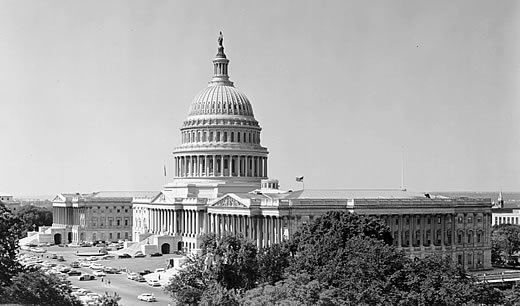The Seventy-seventh United States Congress was a meeting of the legislative branch of the United States federal government, composed of the United States Senate and the United States House of Representatives. It met in Washington, DC from January 3, 1941 to January 3, 1943, during the ninth and tenth years of Franklin Roosevelt's presidency. The apportionment of seats in the House of Representatives was based on the Sixteenth Census of the United States in 1940. Both chambers had a Democratic majority.
This was the first Congress to have more than one Senate President (the Vice President of the United States), John Garner and Henry Wallace, due to the passage of the 20th amendment in 1933.
December 7, 1941: Attack on Pearl HarborDecember 8, 1941: Joint Session of Congress met to hear President Roosevelt deliver his "Day of Infamy" speechDecember 26, 1941: Joint session of the United States Congress met in the Senate chamber for an address by British Prime Minister Winston Churchill.Major legislation and resolutions
March 11, 1941: Lend Lease Act, Pub.L. 77–11, Sess. 1, ch. 11, 55 Stat. 31August 18, 1941: Flood Control Act of 1941, Pub.L. 77–228, Sess. 1, ch. 377, 55 Stat. 638December 8, 1941: Resolution— War between United States and Japan, Pub.L. 77–328, Sess. 1, ch. 561, 55 Stat. 795December 11, 1941: Resolution— War between United States and Germany, Pub.L. 77–331, Sess. 1, ch. 564, 55 Stat. 796December 11, 1941: Resolution— War between United States and Italy, Pub.L. 77–332, Sess. 1, ch. 565, 55 Stat. 797January 30, 1942: Emergency Price Control Act of 1942, Pub.L. 77–421, Sess. 2, ch. 26, 56 Stat. 23June 5, 1942: Resolution— War between United States and Bulgaria, Pub.L. 77–563, Sess. 2, ch. 323, 56 Stat. 307June 5, 1942: Resolution— War between United States and Hungary, Pub.L. 77–564, Sess. 2, ch. 324, 56 Stat. 307June 5, 1942: Resolution— War between United States and Romania, Pub.L. 77–565, Sess. 2, ch. 325, 56 Stat. 307June 22, 1942: Resolution— United States Flag Code, including recognition of the Pledge of Allegiance, Pub.L. 77–623, Sess. 2, ch. 435, 56 Stat. 377October 2, 1942: Stabilization Act of 1942, Pub.L. 77–729, Sess. 2, ch. 578, 56 Stat. 765Truman Committee (officially the United States Senate Special Committee to Investigate the National Defense Program)President: John Nance Garner (D), until January 20, 1941Henry A. Wallace (D), from January 20, 1941President pro tempore: Pat Harrison (D), until June 22, 1941Carter Glass (D), from July 10, 1941Majority leader: Alben W. BarkleyMajority Whip: Lister HillCaucus Secretary: Joshua B. LeeMinority leader: Charles L. McNaryRepublican Conference Secretary: Wallace H. White, Jr.Speaker: Sam Rayburn (D)Majority leader: John William McCormackDemocratic Whip: Patrick J. Boland, until May 18, 1942Robert RamspeckDemocratic Caucus Chairman: Richard M. DuncanDemocratic Campaign Committee Chairman: Patrick H. DrewryMinority leader: Joseph William Martin, Jr.Republican Whip: Harry Lane Englebright, until May 13, 1943Republican Conference Chairman: Roy O. Woodruff267 Democratic162 Republican3 Progressive1 American Labor1 Farmer-Labor1 Independent DemocratTotal 435
Senators are elected statewide every two years, with one-third beginning new six-year terms with each Congress. Preceding the names in the list below are Senate class numbers, which indicate the cycle of their election.
The count below reflects changes from the beginning of this Congress.
Lists of committees and their party leaders.
Agriculture and ForestryAgricultural Labor Shortages in the West (Special)AppropriationsAudit and Control the Contingent Expenses of the SenateBanking and CurrencyCivil ServiceCivil Service Laws (Special)ClaimsCommerceDistrict of ColumbiaEducation and LaborEnrolled BillsExpenditures in Executive DepartmentsFinanceForeign RelationsFiscal Affairs of the Government (Special)Fuel Situation in the Middle West (Special)Fuels in the Areas West of the Mississippi (Special)Gasoline and Fuel Oil Shortages (Special)ImmigrationImmigration and NaturalizationIndian AffairsInteroceanic CanalsInterstate CommerceInvestigate the National Defense Program (Special)JudiciaryLibraryManufacturesMilitary AffairsMines and MiningNaval AffairsOld-Age Pension System (Select)PatentsPensionsPost Office and Post RoadsPrintingPrivileges and ElectionsPublic Buildings and GroundsPublic Lands and SurveysRulesSenatorial Campaign Expenditures (Special)Small Business Enterprises (Special)Territories and Insular AffairsWholeWildlife Resources (Special)Wool Production (Special)AccountsAgricultureAir Accidents (Select)AppropriationsBanking and CurrencyCensusCivil ServiceClaimsCoinage, Weights and MeasuresDisposition of Executive PapersDistrict of ColumbiaEducationElection of the President, Vice President and Representatives in CongressElectionsEnrolled BillsExpenditures in the Executive DepartmentsFlood ControlForeign AffairsImmigration and NaturalizationIndian AffairsInsular AffairsInterstate and Foreign CommerceInvalid PensionsIrrigation and ReclamationLaborMemorialsMerchant Marine and FisheriesMilitary AffairsMines and MiningNaval AffairsPatentsPensionsPost Office and Post RoadsPublic Buildings and GroundsPublic LandsRevision of LawsRivers and HarborsRoadsRulesSmall Business (Select)Standards of Official ConductTerritoriesWar ClaimsWays and MeansWholeConditions of Indian Tribes (Special)Disposition of (Useless) Executive PapersEradication of the Meditteranean Fruit FlyForestryThe LibraryReduction of Nonessential Federal ExpendituresTaxationTo Investigate Phosphate Resource of the United StatesArchitect of the Capitol: David LynnAttending Physician of the United States Congress: George CalverComptroller General of the United States: Lindsay C. WarrenLibrarian of Congress: Archibald MacLeishPublic Printer of the United States: Augustus E. GiegengackSecretary: Edwin A. HalseySergeant at Arms: Chesley W. JurneyParliamentarian: Charles WatkinsChaplain: ZeBarney Thorne Phillips (until October 9, 1942), Frederick Brown Harris (after October 10, 1942)Clerk: South TrimbleSergeant at Arms: Kenneth RomneyParliamentarian: Lewis DeschlerReading Clerks: Irving SwansonChief Administrative Officer:Doorkeeper of the House: Joseph J. SinnottPostmaster: Finis E. ScottChaplain: James Shera Montgomery (Methodist) 
